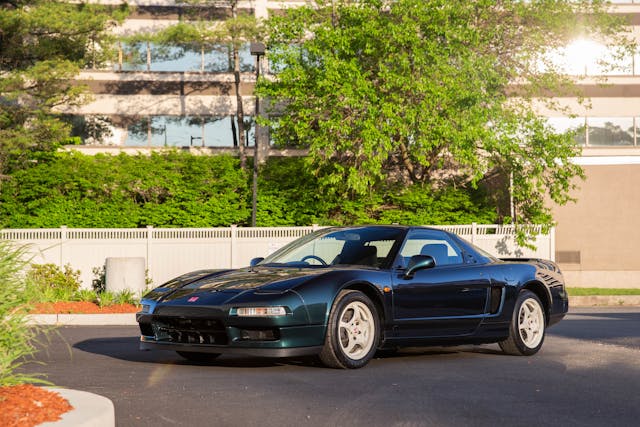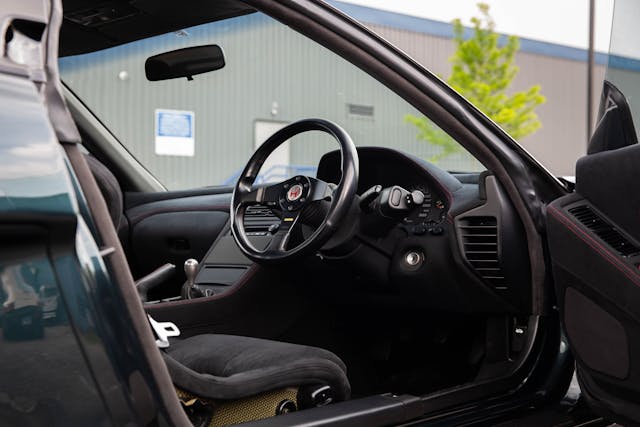Do these 3 ’90s Japanese heroes live up to the video-game hype?
We try very hard around here to explain why certain cars are worth what they are. Provenance, condition, and rarity all have roles to play, as do buyer demographics and economic externalities. Lost in all that, though, is a simpler explanation: Some cars become darlings of the collector-car market because they’re a hoot to drive. Or at least, because people think they are. Noted economists and sociologists who study this phenomenon have labeled it “The 1990s Japanese Car Effect.”
That last part is in jest, of course, but only a little. Japanese Domestic Market (JDM) cars have never, ever been hotter. The demand, in large part, comes from Gen-Xers and millennials who have spent countless hours “driving” these cars in video games and watching others describe how brilliant they are on YouTube. Japanese automakers in the 1990s, so the theory goes, found the sweet spot between modern capability and an old-school, analog experience.

That got us asking the age-old question: Does the driving experience truly match the hype? Matthew Ivanhoe, noted collector in his own right and owner/operator of The Cultivated Collector in New Canaan, Connecticut, helped us pursue the answer by offering time behind the wheel of a triad of Bring a Trailer–bound 1990s Japanese classics that represent the very apex of the segment: a 1994 Nissan Skyline GT-R V-Spec II N1, a 1996 Honda Integra Type R, and a Honda NSX-R.
Godzilla is polite
Before going much further, a note about me: As an obsessive enthusiast of everything wearing four wheels, I respect Japan’s legends and their impact on car culture … but I don’t crave ’em. The Japanese car bug shot over my millennial head like a thousand-horse, single-turbo Supra. I was in no danger of being let down by any of these cars, nor did I feel beholden to affirming any mythical attribute of a given chassis.

Nevertheless, getting a crack at this particular breed of Godzilla did make it a little hard to check emotions at the door. Ivanhoe’s blindingly white GT-R is hardly one of the thousands of “ordinary” R32-gen Skylines already clogging your local cars and coffee. It’s one of just 63 V-Spec II N1s created for component homologation in Japan’s namesake N1 race series, and is easily one of the most sought-after variants of the Nissan GT-R. This was the production car that directly led to the R32’s outright dominance of nearly every motorsports series in which it competed.
No surprise, the N1 is among the most valuable of GT-Rs, and the delta between it and the rest is widening. Where the value of the average R32-generation GT-R rose a strong 18 percent in our latest update to the Hagerty Price Guide, the N1 went atomic with a neat 100 percent increase over our previous iteration. An average (condition #3) R32 N1 goes for $200,000; top-condition (#1) examples like Ivanhoe’s 7800 km car are nearing the half-million mark.
Under Nismo’s lightweight, aluminum front hood resides the main attraction. The 2.6-liter twin-turbo RB26DETT inline-six is in hand-built, blueprinted “N1” spec, carrying N1-specific block, internals, and turbocharger, with the remaining hardware pulled from the Nismo-spec R32 GT-R. These modifications were made in the name of durability, and Nissan adhered, at least on paper, to the 276-hp limit from Ye Olde Japanese Manufacturer’s Gentleman’s Agreement. So, the official power output remains unchanged from garden-variety GT-Rs. Nevertheless, an R32 N1 with a simple exhaust-mod is reputed to put down just over 404 hp at the wheels.

The rest of the N1 is best represented in what’s not there. ABS was left on the shelf, as was sound system, air-conditioning, and rear wiper. Every N1 arrived with whisper-thin white paint, ostensibly saving some 66 pounds in the process. Later N1s like this one came in V-spec—V as in “victory”—guise, incorporating Brembo brakes, special BBS wheels, and a revised version of its four-wheel steering system. V-Spec II represents the final iteration, with slightly wider wheels.
In contrast to its status as a souped-up, stripped-out homologation special, the N1 idles under the summer sun with all the ferocity of a modern hot hatch. YouTube and Instagram overflow with clips of shrieking R32-R34 GT-Rs, most tuned to two, three, or even four times the stated factory horsepower. It’s almost unnerving to hear the N1’s special RB sound so corked.
Despite its movie-monster nickname, the N1 is incredibly confidence-inspiring. Aside from the right-hand-drive configuration, this is one of the tamest, most approachable homologation performance cars on the planet. The R32 N1 scoots around like a heavy Mitsubishi Evo with the heart of a modern M3. Perhaps unsurprisingly, it feels exactly like the analog, mechanical predecessor to the R35 GT-R that it is.

And like the current generation of Godzilla, it’s almost prosaic in its composure. On tight, stone-lined roads weaving through suburban Connecticut, the N1 claws through corners and undramatically presses into superlegal speeds. It’s quick, quiet, accessible—and in some ways forgettable. It’s analog in the way all cars from this era are, but not without a surprising overlay of modernity.
That’s the problem with separating a holotype from the genre it revolutionized. Frank Herbert’s Dune reads exactly like a generic political sci-fi novel unless one understands the literary landscape just prior to its publishing: It created the sci-fi tropes it appears to be regurgitating. In its day, nothing gripped or ripped like the R32 GT-R. Today, a Porsche Cayenne Turbo will perform many of the same tricks, propped-up by technologies pioneered in part by the GT-R.
Shaking a wasps' nest
If the N1 feels milled from a single block of aerospace aluminum, Ivanhoe’s 1996 Honda Integra Type-R is a bundle of thoroughly shaken wasp nests. Swapping mid-route from a heavy-ish, all-wheel-drive, turbo missile into a naturally aspirated, front-wheel drive buzzbox is akin to slipping from a sauna into a frozen pond.
Any enthusiast with a passing interest in Japanese metal from the ’90s knows this car’s tale—the merits of our USDM Acura Integra Type R are canonical at this point—but it’s worth revisiting.

Honda’s stripped-down, peaked-out super-compact is often labeled as the best-handling front-wheel-drive car of all time, thanks to careful engineering gleaned from Honda’s successful race cars. Comprehensive chassis upgrades significantly improved rigidity; stripping insulation and lightening other bits—even the floormats—shaved 93 pounds. The 1.8-liter B18C four-cylinder is easily one of the best four-pots ever produced, with a strong 195-hp peak against an 8700-rpm redline.
This isn't my first time in an ITR. A couple of years back, I had extended seat time on Angeles Crest Highway above L.A. with a museum-grade USDM Integra Type R pulled from Honda’s own archive. I walked away impressed but confused. At around $80,000 in today’s market in that condition, I couldn’t quite get a handle on the American ITR’s dollars-per-grin ratio.
Ivanhoe’s white JDM ITR shook this perspective. Wearing around 24,000 kilometers as of the time of my short drive, it was just as well-preserved as the archival USDM ITR, only this car sported some JDM-dedicated OEM improvements as well as choice Mugen parts that tightened my headscrews in the best possible way.
Consider this car the opposite of a sensory deprivation tank. The tight, hyper-intuitive shifter is a joy to snap-shift right at the 8700-rpm redline. Inputs—most notably the steering—are richly communicative. Like the GT-R, the engine is the keystone but in a very, very different way. The engine crescendos swiftly and sweetly to the limit, with VTEC engaging somewhere around the 6000-rpm mark, rewarding deep throttle operation. It positively screams.

I acquiesce—this is a very, very special car. Yet there's a reason a short drive in Ivanhoe’s previously verboten Integra zapped my soul harder than my Angeles rip in a USDM ITR: The imported Honda is better. JDM ITRs have higher compression than their USDM counterparts and wear a different header and a less restrictive exhaust system. The JDM ITR’s final-drive ratio is higher, too, and you get far better seats and a thinner, sportier three-spoke steering wheel. Here’s the best part—JDM ITRs are notably cheaper than the cheeseburger counterpart, because supply is significantly higher for right hand-drive versions.
Pick one: $10,000 to $15,000 extra in your pocket, or the ability to efficiently use fast food drive-thrus. I’d unplug that morphine drip of nostalgia and buy the better, cooler, and more affordable car.
The best Japanese driver's car

I’m afraid I cannot extend the same advice to the third and final JDM goliath, the NSX-R, as both supply and affordability are best discussed “on request.” We’d love to present a platter of valuation data here, but there’s a stunning lack of reference sales from which to draw. Back in 2019, BH Auctions in Japan offered two, one selling for $447,000 and the other for $285,000. But that was before the latest market rush, and it was a Japanese auction. When Ivanhoe’s Brooklands Green 1993 Honda NSX-R lands on BaT in the near future, we believe it will be the first time an NSX-R has come up for public auction in the western hemisphere.
Despite missing a "Type" in the name, the "R" treatment here was similar to that for the Integra Type-R, except of course, that Acura was starting with an NSX. Sound deadening, spare tire, air-conditioning, sound system, and traction control were all scrapped. Fixed-back, carbon-Kevlar race buckets and featherweight Enkei wheels replace the standard leather chairs and aluminum rims. All this Slim Fast nixes 265 pounds from the final weigh-in, cutting the final tally to an eggshell 2710 pounds.
Honda chucked the entire base suspension for the NSX-R, substituting stiffer sway bars, bushings, springs, and dampers. A higher final-drive ratio provides stronger acceleration, and a new, locking limited-slip differential plays nice with a balanced and blueprinted version of the standard C30A 3.0-liter naturally aspirated V-6.

The result is one of the most rewarding methods to burn gas, ever. It's a crystallization of balance, capability, sensation, and speed unlike anything made in the past decade. In sharp contrast to the N1, there’s no homework required to contextualize the NSX-R outside of what it offers as an immediate experience. From the weight and pick-up of the clutch, to the shift motion, to the brake balance and pedal pressure, to the throttle actuation, to the steering weight—every tactile point integrates you with the car.
The drivetrain is surprisingly the least remarkable aspect, but only because everything else is so exceptional. The 3.0-liter V-6 does its best snorting, screaming big-sibling version of the ITR’s underhood pipebomb, that intoxicating intake rush lancing through the unmuffled cabin. Pace is not significantly changed over that of the production NSX, but it’s edgier, sharper. It surges forward and crashes over bumps, playing the telltale soundtrack of pinging pebbles and clattery clutch. It’s absolutely symphonic.

Some of what I've said here likely has you heated. And why not? I'm casting rough judgement on cars that have consumed every neuron of your car-brain for the past 30 years. This nostalgia-free approach is my whole point. Japanese cars of the 1990s and early 2000s—both JDM and USDM—started out for many of us as video game renderings, and now they're fast becoming assets; but at the end of the day, they're still just cars and the collectors snapping them up are still just people, with widely varying and entirely subjective definitions of what feels good and what doesn't. If you're one of those people, do yourself a favor: Chase after your Japanese passion-car, but go drive it with eyes wide open before signing the check. It's the best way to save yourself some potential heartache.


